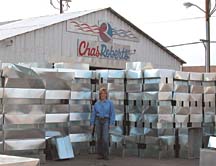In fact, Chas Roberts A/C is so ubiquitous, you’d be hard pressed to find any neighborhood under construction here without at least one of the company’s vans parked on the street. Unlike other large U.S. markets, where four or five major contractors usually vie for a piece of the new residential construction pie, Chas Roberts commands approximately 75 percent of this market in the Greater Phoenix area.
As a result, the company’s annual sales have grown from approximately $24 million in 1984 to $130 million in 2002. Since approximately 95 percent of its total income comes from residential new construction, Chas Roberts is considered the home run king among The News’ Residential New Construction All-Stars.

All In The Family
The company’s aim is really quite simple: “If you have a house, we want to be in it,” said Sissie Roberts Shank, president and CEO. Shank is the granddaughter of Chas Roberts, who founded the company in 1942. His son, Chuck, took over the business in the 1960s, and Shank, who has managed the company since 1999, credits him with the success the company is enjoying today.“My father did a great job of really focusing on production-oriented jobs. We used to be a scattered company that did a little light commercial, a little residential, a few apartment buildings,” said Shank. “He thought we’d be better off sticking to our niche, getting as much efficiency in buying as we could by staying with main lines and sizes and really focusing on production.”
Choosing to focus on the residential new construction market was a stroke of genius. The Greater Phoenix area continues to be one of the fastest growing areas in the country, more than doubling its population in the last 20 years.

One of the reasons Chuck Roberts wanted to focus on residential new construction, said Shank, is that in-stalling systems in tract homes is much easier than other types of HVAC work. Once a system is designed for a tract home, it can be used again and again — whereas each stand-alone building usually requires a new design, depending on the building. And if a tract homebuilder is successful in one location, chances are they’ll build the same houses somewhere else.
“That makes it easy for us, because we can use the same plan. We don’t have to refigure the duct and re-engineer it. We can just roll it over and just look at how our costs have changed,” noted Shank. “My father really pushed production — how we laid out houses, what kind of ductwork would be used, and which types of equipment would be installed. Now we take the same process and look for ways to make it more efficient.”

Keeping Costs Down
Overhead is a big issue at Chas Roberts A/C Co., and the company is always looking for ways to keep it down. Working as efficiently as possible is also one of the main reasons why the contractor has been so successful.For example, the company purchases tracts of land all over its service area — from Queen Creek to Goodyear and Scottsdale to Tucson — in order to keep its technicians working more efficiently.
“We try to install yards where the building is taking place. Then our employees just have to report to the local yard, rather than coming to a central location,” said Shank.
In fact, the company just added a yard in the far East Valley, because it was taking technicians almost 40 minutes to get from the Mesa yard to some of the areas in Queen Creek.
“We are also a no-debt company,” said Shank. “We focus on air conditioning. We don’t try to make a lot of money off of side deals, and we don’t make risky investments. We internally finance all capital purchases, so we don’t have a lot of liability.”
The company installs equipment from four equipment manufacturers: Carrier, Trane, Goodman, and York. Shank said that these companies have been very good to Chas Roberts over the years and that the long-lasting relationships have helped the company flourish.
Branching Out
While the company plans to retain its status as the premiere contractor in the residential new construction market, it is also looking to the future. Housing starts can’t keep up their record pace forever, so Chas Roberts has recently branched out to a related area. Its new goal is to dominate the add-on/replacement business in addition to the new construction market.Three years ago the company started its Extended Services Division, which focuses on the retrofit and service markets. The growth rate in that division has been 10 percent to 15 percent each year since its inception.
This seems to be a natural extension for Chas Roberts, since chances are, the company installed the equipment in the first place. As Shank noted, “If we take care of these people, then hopefully they’ll want to stay with us for 10 years and have us replace their units.”
The company hasn’t always been so forward thinking when it comes to service. Not that long ago, Chas Roberts would turn away customers if they called for service after the one- or two-year warranty period expired.
“We threw away a huge opportunity there,” said Shank. “Unfortunately, we had no other choice at the time. We simply couldn’t handle the amount of service calls that came in. The warranty work had to take precedence for us, because residential new construction is our niche.”
That situation has been remedied, though, with the creation of the Extended Services Division. Now, said Shank, “I’m hoping that five years from now we will hold a huge percentage of the retrofit market as well as the residential new construction market.”
Publication date: 09/08/2003


Report Abusive Comment